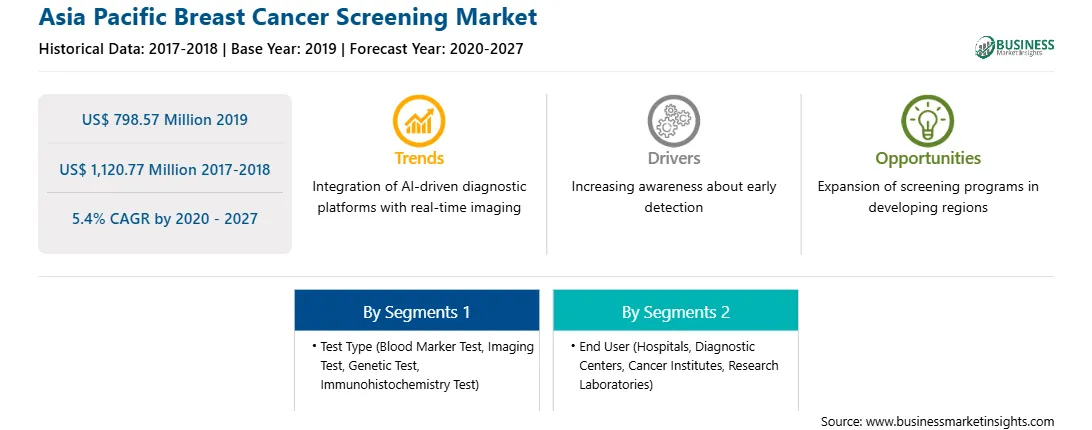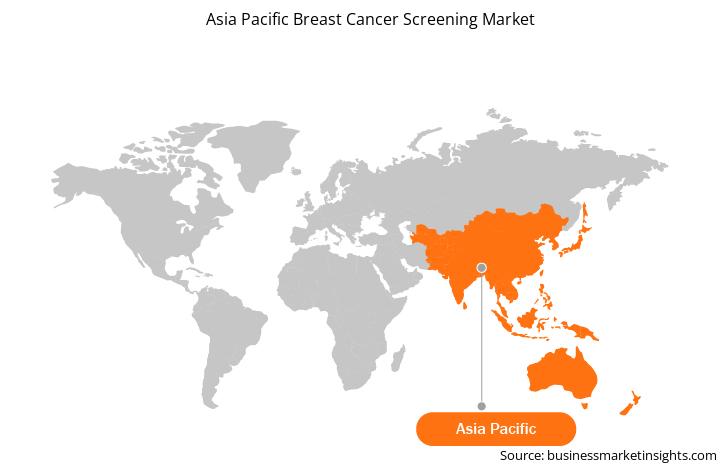As per the Centers for Disease Control and Prevention (CDC) definition, breast cancer screening refers tochecking a woman’s breasts for cancer before there are signs or symptoms of the disease. The purpose of screening tests is to discover cancer at an early stage when it can be operated or cured. At times, a screening test detects cancer when it is very small or growingslowly.
Strategic insights for the Asia Pacific Breast Cancer Screening provides data-driven analysis of the industry landscape, including current trends, key players, and regional nuances. These insights offer actionable recommendations, enabling readers to differentiate themselves from competitors by identifying untapped segments or developing unique value propositions. Leveraging data analytics, these insights help industry players anticipate the market shifts, whether investors, manufacturers, or other stakeholders. A future-oriented perspective is essential, helping stakeholders anticipate market shifts and position themselves for long-term success in this dynamic region. Ultimately, effective strategic insights empower readers to make informed decisions that drive profitability and achieve their business objectives within the market.

| Report Attribute | Details |
|---|---|
| Market size in 2019 | US$ 798.57 Million |
| Market Size by 2027 | US$ 1,120.77 Million |
| CAGR (2020 - 2027) | 5.4% |
| Historical Data | 2017-2018 |
| Forecast period | 2020-2027 |
| Segments Covered |
By Test Type
|
| Regions and Countries Covered | Asia-Pacific
|
| Market leaders and key company profiles |
|
The geographic scope of the Asia Pacific Breast Cancer Screening refers to the specific areas in which a business operates and competes. Understanding local distinctions, such as diverse consumer preferences (e.g., demand for specific plug types or battery backup durations), varying economic conditions, and regulatory environments, is crucial for tailoring strategies to specific markets. Businesses can expand their reach by identifying underserved areas or adapting their offerings to meet local demands. A clear market focus allows for more effective resource allocation, targeted marketing campaigns, and better positioning against local competitors, ultimately driving growth in those targeted areas.

Increasing research activities is likely to enhance the breast cancer screening market in Asia Pacific. For instance, “Novel combination of serum microRNA for detecting breast cancer in the early stage” was conducted in Japan. Furthermore, the government in Japan has initiated cancer control programs as it is one of the leading cause of death in Japan. Cancer screening programs are carried out throughout the country by the municipalities with the government support.
Additionally, increasing research for early diagnosis of breast cancer is likely to favor the breast cancer screening market in Australia. For instance, in October 2019, a NBCF funded (national breast cancer foundation) researcher Sydney University published theresults of pilot trial of 3D mammography (known as tomosynthesis), as per thestudy, breast cancer detection rates are higher with 3D mammography as compared withthe standard 2D mammography.
Test Type-Based Market Insights
Based on test type,the breast cancer screeningmarket is segmented into imaging test, Immunohistochemistry test, genetic test, and blood marker tests. In 2019,the imaging testsegment held the largest share of the market in 2019; moreoverit is anticipated to register the highest CAGR in the market during the forecast period.
Strategic insights for the Asia Pacific Breast Cancer Screening provides data-driven analysis of the industry landscape, including current trends, key players, and regional nuances. These insights offer actionable recommendations, enabling readers to differentiate themselves from competitors by identifying untapped segments or developing unique value propositions. Leveraging data analytics, these insights help industry players anticipate the market shifts, whether investors, manufacturers, or other stakeholders. A future-oriented perspective is essential, helping stakeholders anticipate market shifts and position themselves for long-term success in this dynamic region. Ultimately, effective strategic insights empower readers to make informed decisions that drive profitability and achieve their business objectives within the market.

| Report Attribute | Details |
|---|---|
| Market size in 2019 | US$ 798.57 Million |
| Market Size by 2027 | US$ 1,120.77 Million |
| CAGR (2020 - 2027) | 5.4% |
| Historical Data | 2017-2018 |
| Forecast period | 2020-2027 |
| Segments Covered |
By Test Type
|
| Regions and Countries Covered | Asia-Pacific
|
| Market leaders and key company profiles |
|
The geographic scope of the Asia Pacific Breast Cancer Screening refers to the specific areas in which a business operates and competes. Understanding local distinctions, such as diverse consumer preferences (e.g., demand for specific plug types or battery backup durations), varying economic conditions, and regulatory environments, is crucial for tailoring strategies to specific markets. Businesses can expand their reach by identifying underserved areas or adapting their offerings to meet local demands. A clear market focus allows for more effective resource allocation, targeted marketing campaigns, and better positioning against local competitors, ultimately driving growth in those targeted areas.

Based onend user, the breast cancer screeningmarketis further segmented into hospitals, diagnostic centers, cancer institutes, and research laboratories. The hospitals segment held the largest share of the market in 2019; moreoverit is estimated to register the highest CAGR in the market during the forecast period.
Product launches and approvalsarethe commonly adopted strategies by companies to expand their footprint worldwide and meet the growing demand. The players operating in the breast cancer screeningmarketadopt the expansion, collaboration, and product launch strategies to enlarge customer base acrossthe world.These strategies allow the players to maintain their brand name globally. For instance, in October 2018, GE Healthcare launched a product, namely, the Invenia Automated Breast Ultrasound (ABUS) 2.0 in the US. The device is FDA-approved ultrasound supplemental breast screening technology, specifically designed for detecting cancer in dense breast tissue.
The List of Companies - Asia Pacific Breast Cancer Screening Market
The Asia Pacific Breast Cancer Screening Market is valued at US$ 798.57 Million in 2019, it is projected to reach US$ 1,120.77 Million by 2027.
As per our report Asia Pacific Breast Cancer Screening Market, the market size is valued at US$ 798.57 Million in 2019, projecting it to reach US$ 1,120.77 Million by 2027. This translates to a CAGR of approximately 5.4% during the forecast period.
The Asia Pacific Breast Cancer Screening Market report typically cover these key segments-
The historic period, base year, and forecast period can vary slightly depending on the specific market research report. However, for the Asia Pacific Breast Cancer Screening Market report:
The Asia Pacific Breast Cancer Screening Market is populated by several key players, each contributing to its growth and innovation. Some of the major players include:
The Asia Pacific Breast Cancer Screening Market report is valuable for diverse stakeholders, including:
Essentially, anyone involved in or considering involvement in the Asia Pacific Breast Cancer Screening Market value chain can benefit from the information contained in a comprehensive market report.